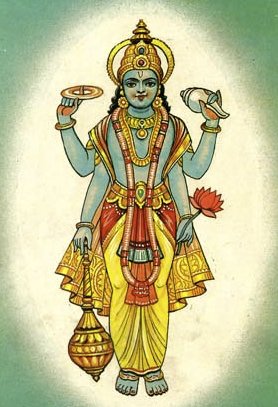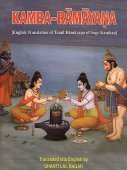Setubandha, Setu-bandha, Setubamdha: 13 definitions
Introduction:
Setubandha means something in Hinduism, Sanskrit, the history of ancient India, Marathi. If you want to know the exact meaning, history, etymology or English translation of this term then check out the descriptions on this page. Add your comment or reference to a book if you want to contribute to this summary article.
In Hinduism
Vaishnavism (Vaishava dharma)
Source: Prabhupada Books: Sri Caitanya CaritamrtaSetubandha (सेतुबन्ध).—According to Śrī Caitanya Caritāmṛta, Madya-lila 9.199, “Śrī Caitanya Mahāprabhu then went to Setubandha [Rāmeśvara], where He took His bath at the place called Dhanustīrtha. From there He visited the Rāmeśvara temple and then took rest”.
The island of Pambam is about eleven miles long and six miles wide. On this island, four miles north of Pambam Harbor, is Setubandha, where the temple of Rāmeśvara is located. This is a temple of Lord Śiva, and the name Rāmeśvara indicates that he is a great personality whose worshipable Deity is Lord Rāma. Thus the Lord Śiva found in the temple of Rāmeśvara is a great devotee of Lord Rāmacandra.

Vaishnava (वैष्णव, vaiṣṇava) or vaishnavism (vaiṣṇavism) represents a tradition of Hinduism worshipping Vishnu as the supreme Lord. Similar to the Shaktism and Shaivism traditions, Vaishnavism also developed as an individual movement, famous for its exposition of the dashavatara (‘ten avatars of Vishnu’).
India history and geography
Source: Shodhganga: a concise history of Sanskrit Chanda literature (history)Setubandha (सेतुबन्ध) is the name of a commentary (on Nityāṣoḍaśikārṇava) on the topic of Mantraśāstra ascribed to Bhāskararāya (C. 1685-1775 C.E.), a polymath of who composed around forty works covering the subjects of vedānta, mīmāṃsā, vyākaraṇa, nyāya, prosody, kāvya, smṛti, mantraśāstra, Vedic literature. Also see the “New Catalogus Catalogorum” XVII. pp. 133-135.
The Setubandha is a part of Vāmakeśvaratantra dealing with the external and internal worship of Śrī Tripurasundarī
Source: What is India: Inscriptions of the VākāṭakasSetubandha (सेतुबन्ध) is the name of a Prakrit kāvya composed by Pravarasena II during the reign of Sarvasena during the Vākāṭakas (mid-3rd century CE).—Pravarasena II of the Senior branch of the Vākāṭaka family distinguished himself by the composition of Prakrit poetry. He is the reputed author of the Prakrit kāvya Setubandha, also called Rāvaṇavaho, in the Mahārāṣṭrī Prakrit.
The Sētubandha has for its theme the epic story of Rāma from his advance against Rāvaṇa and the building of a bridge of stone to Laṅkā to his return to Ayodhyā after the extermination of the demon king. The work is divided into fifteen cantos called āśvāsas, and contains 1362 verses. The prevailing metre is Skandhaka, but verses in other metres also are interspersed in the middle and also added at the end of each canto.
The Setubandha is composed in an artistic style considered suitable for a mahākāvya, with the use of puns and long compounds. It was plainly written for a public which was well versed in Sanskrit, and contains a description of all the topics considered essential in a Sanskrit mahākāvya. It has been highly praised by Sanskrit poets and rhetoricians. Bāṇa says in his Harṣacarita that by means of this Sētu (i.e. Sētubandha) the fame of Pravarasena crossed the ocean, as the army of monkeys had done before by means of the bridge (of Rāma)

The history of India traces the identification of countries, villages, towns and other regions of India, as well as mythology, zoology, royal dynasties, rulers, tribes, local festivities and traditions and regional languages. Ancient India enjoyed religious freedom and encourages the path of Dharma, a concept common to Buddhism, Hinduism, and Jainism.
Languages of India and abroad
Marathi-English dictionary
Source: DDSA: The Molesworth Marathi and English Dictionarysētubandha (सेतुबंध).—m (S) The ridge of rocks extending from the south extremity of the Coromandel coast towards the island of Ceylon, supposed to have been formed by Hanuman at the command of Rama, as a bridge for the passage of his forces when marching against Rawan̤, Adam's bridge.
Marathi is an Indo-European language having over 70 million native speakers people in (predominantly) Maharashtra India. Marathi, like many other Indo-Aryan languages, evolved from early forms of Prakrit, which itself is a subset of Sanskrit, one of the most ancient languages of the world.
Sanskrit dictionary
Source: DDSA: The practical Sanskrit-English dictionarySetubandha (सेतुबन्ध).—
1) the forming or construction of a bridge, cause-way &c.; Kau. A.2.1; वयोगते किं वनिता- विलासो जले गते किं खलु सेतुबन्धः (vayogate kiṃ vanitā- vilāso jale gate kiṃ khalu setubandhaḥ) Subhāṣ.; Kumārasambhava 4.6.
2) the ridge of rocks extending from the southern extremity of the Coromandel coast towards Ceylon (said to have been built for Rāma's passage to Laṅkā by Nala and the other monkeys); Bhāgavata 7.14.31.
3) any bridge or cause-way.
Derivable forms: setubandhaḥ (सेतुबन्धः).
Setubandha is a Sanskrit compound consisting of the terms setu and bandha (बन्ध).
Source: Cologne Digital Sanskrit Dictionaries: Shabda-Sagara Sanskrit-English DictionarySetubandha (सेतुबन्ध).—m.
(-ndhaḥ) 1. The ridge of rocks extending from the south extremity of the Coromandel coast towards the island of Ceylon, supposed to have been formed by Hanuman by command of Rama, as a bridge for the passage of his forces, when going against Ravana. 2. Any dyke or dam, &c. E. setu a bridge, bandha a binding.
Source: Cologne Digital Sanskrit Dictionaries: Benfey Sanskrit-English DictionarySetubandha (सेतुबन्ध).—m. 1. a dike, [Rājataraṅgiṇī] 5, 92. 2. the ridge of rocks between the Coromandel coast and Ceylon.
Setubandha is a Sanskrit compound consisting of the terms setu and bandha (बन्ध).
Source: Cologne Digital Sanskrit Dictionaries: Cappeller Sanskrit-English DictionarySetubandha (सेतुबन्ध).—[masculine] the building of a dam or bridge, T. of a poem in Prākrit.
Source: Cologne Digital Sanskrit Dictionaries: Aufrecht Catalogus Catalogorum1) Setubandha (सेतुबन्ध) as mentioned in Aufrecht’s Catalogus Catalogorum:—the name of the 13th book of the Bhaṭṭikāvya.
2) Setubandha (सेतुबन्ध):—mantra, by Paṇḍitācārya. Rice. 300.
3) Setubandha (सेतुबन्ध):—a Prākṛt poem on the history of Rāma, attributed to Pravarasena and sometimes to Kālidāsa. Io. 667. W. p. 367. L. 1977. K. 64. Kh. 86. Ben. 36. Burnell. 175^a. Lahore. 2. P. 3. 10. Oppert. Ii, 9852. Bu7hler 540 (and—[commentary]). Mentioned by Daṇḍin in the Kāvyādarśa, by Ānandavardhana in the Dhvanyāloka.
—[commentary] by Kulanātha. L. 1978. W. 1554.
—[commentary] by Rāmadāsa. Io. 1124. W. p. 367. K. 64. B. 2, 102. Report. Xii. Lahore. 2. W. 1552.
—[commentary] by Śrīkṛṣṇa. Burnell. 175^a. W. 1553. Setusaraṇi, a Saṃskṛt translation of the text, by Śivanārāyaṇadāsa. W. p. 154.
Setubandha has the following synonyms: Rāmasetu, Rāvaṇavaha.
4) Setubandha (सेतुबन्ध):—Kādimatatantraṭīkā by Bhāskara.
—Vāmakeśvaratantraṭīkā by the same.
5) Setubandha (सेतुबन्ध):—Rasataraṅgiṇīṭīkā by Jīvarāja.
6) Setubandha (सेतुबन्ध):—a Prākṛt poem, attributed to Pravarasena. Rgb. 402. First published by Siegfried Goldschmidt (1880-84), afterwards, without taking any notice of this excellent edition, in the Kāvyamālā 47 (1895).
—[commentary] by Rāmadāsa. Rgb. 402.
Setubandha has the following synonyms: Rāmasetu, Rāvaṇavaha.
7) Setubandha (सेतुबन्ध):—kāvya, attributed to Kālidāsa. Ulwar 2471.
—[commentary] by Rāmadāsa. Ulwar 2472.
8) Setubandha (सेतुबन्ध):—a Prākṛt poem. Bc 263. C. Rāmasetupradīpa by Rāmadāsa. Peters. 5, 400. C. Setudarpaṇa by Śrīnivāsa, son of Sāgara. Rep. p. 19.
Source: Cologne Digital Sanskrit Dictionaries: Monier-Williams Sanskrit-English Dictionary1) Setubandha (सेतुबन्ध):—[=setu-bandha] [from setu] m. the forming of a causeway or bridge, a dam or bridge ([especially] the ridge of rocks extending from Rāmeśvara on the Southeastern coast of India to Ceylon, and supposed to have been formed by Hanumat as a bridge for the passage of Rāma’s army), [Mahābhārata; Rāmāyaṇa etc.]
2) [v.s. ...] Name of various works ([especially] of the 13th [chapter] of the Bhaṭṭi-kāvya and of a Prākṛt poem on the history of Rāma, also called rāma-setu, or rāvaṇa-vaha, attributed to Pravarasena and sometimes to Kālidāsa).
Source: Cologne Digital Sanskrit Dictionaries: Yates Sanskrit-English DictionarySetubandha (सेतुबन्ध):—[setu-bandha] (ndhaḥ) 1. m. A ridge of rocks near Ceylon, Rāma’s bridge; a dike.
[Sanskrit to German]
Sanskrit, also spelled संस्कृतम् (saṃskṛtam), is an ancient language of India commonly seen as the grandmother of the Indo-European language family (even English!). Closely allied with Prakrit and Pali, Sanskrit is more exhaustive in both grammar and terms and has the most extensive collection of literature in the world, greatly surpassing its sister-languages Greek and Latin.
Kannada-English dictionary
Source: Alar: Kannada-English corpusSētubaṃdha (ಸೇತುಬಂಧ):—[noun] = ಸೇತು - [setu -] 1, 2 & 3.
--- OR ---
Sētubaṃdha (ಸೇತುಬಂಧ):—[noun] the tree Crataeva roxburghii of Capparaceae family.
Kannada is a Dravidian language (as opposed to the Indo-European language family) mainly spoken in the southwestern region of India.
See also (Relevant definitions)
Partial matches: Bandha, Setu.
Starts with: Setubandhana, Setubandhasana, Setubandhasarvangasana.
Ends with: Pashanasetubandha, Svatvavyavastharnavasetubandha, Yoginihridayasetubandha.
Full-text (+16): Setusarani, Ramasetu, Samudraru, Ravanavaha, Yoginihridayasetubandha, Pashanasetubandha, Svatvavyavastharnavasetubandha, Prakritasetu, Setubandhana, Bara Jyotilingem, Dashamukhavadha, Setubandhasana, Cumbaka, Pravarasena, Setubandhasarvangasana, Ali, Ekapadasetubandhasarvangasana, Jivaraja, Shilpashastra, Shodashanityatantra.
Relevant text
Search found 19 books and stories containing Setubandha, Setu-bandha, Sētubandha, Sētu-bandha, Setubamdha, Sētubaṃdha; (plurals include: Setubandhas, bandhas, Sētubandhas, Setubamdhas, Sētubaṃdhas). You can also click to the full overview containing English textual excerpts. Below are direct links for the most relevant articles:
Brihad Bhagavatamrita (commentary) (by Śrī Śrīmad Bhaktivedānta Nārāyana Gosvāmī Mahārāja)
Verse 1.4.45 < [Chapter 4 - Bhakta (the devotee)]
Chaitanya Bhagavata (by Bhumipati Dāsa)
Verse 2.23.287 < [Chapter 23 - Wandering about Navadvīpa On the Day the Lord Delivered the Kazi]
Verse 1.9.190 < [Chapter 9 - Nityānanda’s Childhood Pastimes and Travels to Holy Places]
Verse 3.9.210 < [Chapter 9 - The Glories of Advaita]
The Skanda Purana (by G. V. Tagare)
Section 1 - Setu-māhātmya < [Book 3 - Brāhma-khaṇḍa]
Chapter 36 - Hanumān Makes His Appearance < [Section 2 - Dharmāraṇya-khaṇḍa]
Chapter 101 - Installation of Rāmeśvara in the Middle of the Setu < [Section 1 - Tīrtha-māhātmya]
Garga Samhita (English) (by Danavir Goswami)
Verse 8.13.33 < [Chapter 13 - A Thousand Names of Lord Balarāma]
Verse 8.13.59 < [Chapter 13 - A Thousand Names of Lord Balarāma]
Verses 3.10.31-37 < [Chapter 10 - The Glory of Śrī Girirāja]
Kuntaka’s evaluation of Sanskrit literature (by Nikitha. M)
3. Harivijaya in Kuntaka’s treatment < [Chapter 3 - Kuntaka’s estimation of Mahākāvyas of other Poets]
Introduction < [Chapter 3 - Kuntaka’s estimation of Mahākāvyas of other Poets]
Conclusion to Chapter 3 < [Chapter 3 - Kuntaka’s estimation of Mahākāvyas of other Poets]
Rudra-Shiva concept (Study) (by Maumita Bhattacharjee)
14. Twelve Jyotirliṅga incarnations of lord Śiva < [Chapter 5 - Rudra-Śiva in the Purāṇic Literature]
Related products
